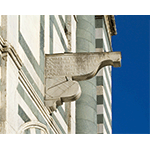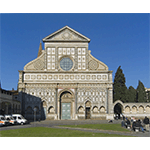Basilica of Santa Maria Novella
The Basilica of Santa Maria Novella constitutes a concrete example of the close relationship between science and art. In the second half of the 15th century, Leon Battista Alberti was entrusted with completing the facade, where he admirably harmonised the medieval elements and the new parts contained in his project. The relationships of the parts amongst themselves and with the entirety are established by a harmonic proportional system derived from simple ratios (one to one, one to two, one to three, etc.), which are at the basis of musical harmony. This system permitted Alberti to define the position and dimension of every element of the facade. The one-to-two relationship governs the composition of the entire facade, which appears inscribed in a square, while a smaller square (with sides equal to half that of the larger square) establishes the relationship between the two floors, breaks up the lower part, and circumscribes the upper central part. This ratio is maintained for all the elements of the facade, so that it appears built geometrically on the basis of a progressive halving or doubling of the measurements, always maintaining the same proportion.
The Basilica interior houses the famous Trinitą by Masaccio which, formulated within an architectural space conceived according to the perspective laws of Filippo Brunelleschi, constitutes another example of the happy union between drawing science and artistic expression.
In the second half of the 16th century, the astronomer, mathematician and geographer at the court of Cosimo I de' Medici, Egnazio Danti placed two astronomical instruments on the facade, which he used to study the apparent motion of the Sun. On the left are two equinoctial circles, while on the right is a quadrant with two sundials on the base. On the marble squares of the facade, to either side of the quadrant, are two carved sundials. The calculations Danti made were important to correct the calendar used until then. The new calendar, known as Gregorian, after Pope Gregory XIII who promoted the reform, established that October 4, 1582 would be immediately followed by October 15. This stratagem corrected a small error present in the calendar promoted by Julius Cesar and known as the Julian calendar. In the same church, Danti also started, but did not finish, the construction of a monumental sundial. Above the rose window, in the green fascia, in the middle, we can still see the gnomonic hole through which a sunbeam was to strike the meridian altitude on the floor inside the church.
The church is also associated to the figure of Galileo Galilei. From the pulpit of the church, in December 1614, Dominican Tommaso Caccini denounced the heretical nature of the Copernican system, also involving Galileo who was a supporter. Several of the Pisan scientist's followers reacted to this, and Caccini reported to the Inquisitor of Florence requesting he repress «certain insolent intellectuals». In his letters to Benedetto Castelli in 1613 and to Christine of Lorraine in 1615, Galileo insisted on the autonomy of science from religion. On February 24, 1616, the Church of Rome condemned the heliocentric thesis, and on March 5 decreed the suspension of the work of Copernicus until it had been corrected. Bellarmino's admonishment to Galileo to abandon the Copernican hypothesis ended what is defined as Galileo's first trial.
****************************
Texts by Graziano Magrini
English translation by Victor Beard
Last update 20/set/2010





